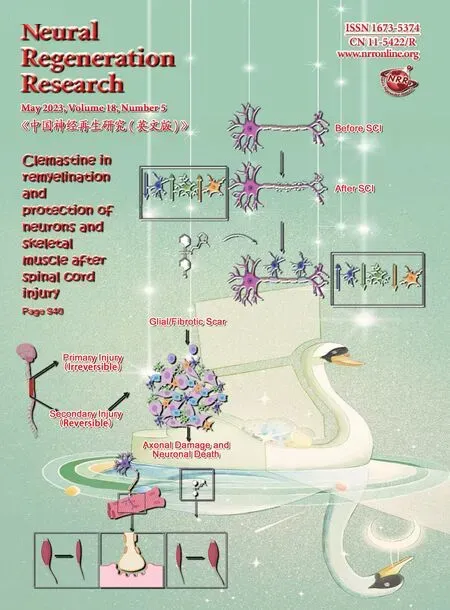中国神经再生研究(英文版)
Reviews
- Chx10+V2a interneurons in spinal motor regulation and spinal cord injury
- Clemastine in remyelination and protection of neurons and skeletal muscle after spinal cord injury
- The effects and potential of microglial polarization and crosstalk with other cells of the central nervous system in the treatment of Alzheimer’s disease
- Patient-specific monocyte-derived microglia as a screening tool for neurodegenerative diseases
- Molecular hallmarks of long non-coding RNAs in aging and its significant effect on aging-associated diseases
- Vimentin as a potential target for diverse nervous system diseases
- Inflammation in diabetic retinopathy: possible roles in pathogenesis and potential implications for therapy
- The critical role of the endolysosomal system in cerebral ischemia
- Novel therapeutic strategies targeting mitochondria as a gateway in neurodegeneration
- Targeting the nitric oxide/cGMP signaling pathway to treat chronic pain
- Neurosteroids as stress modulators and neurotherapeutics: lessons from the retina
- Myelinosome organelles in pathological retinas:ubiquitous presence and dual role in ocular proteostasis maintenance
- Anti-IgLON5 disease: a novel topic beyond neuroimmunology
Perspectives
- Endocannabinoid control of neuroinflammation in traumatic brain injury by monoacylglycerol lipase in astrocytes
- Neuroinflammation and glial activation in the central nervous system: a metabolic perspective
- LL-37 and CsgC exemplify the crosstalk between anti-amyloid,antimicrobial, and anti-biofilm protein activities
- Olfactory dysfunction as a common biomarker for neurodegenerative and neuropsychiatric disorders
Research Articles
- Blocking postsynaptic density-93 binding to C-X3-C motif chemokine ligand 1 promotes microglial phenotypic transformation during acute ischemic stroke
- Ischemic accumulation of succinate induces Cdc42 succinylation and inhibits neural stem cell proliferation after cerebral ischemia/reperfusion
- Neutrophil-derived interleukin-17A participates in neuroinflammation induced by traumatic brain injury
- Integrin binding peptides facilitate growth and interconnected vascular-like network formation of rat primary cortical vascular endothelial cells in vitro
- A benchtop brain injury model using resected donortissue from patients with Chiari malformation
- Double-target neural circuit-magnetic stimulation improves motor function in spinal cord injury by attenuating astrocyte activation
- Alterations in gut microbiota are related to metabolite profiles in spinal cord injury
- Assessment of hindlimb motor recovery after severe thoracic spinal cord injury in rats: classification of CatWalk XT® gait analysis parameters
- Neural progenitor cells derived from fibroblasts induced by small molecule compounds under hypoxia for treatment of Parkinson’s disease in rats
- Neuroprotective effects of insulin-like growth factor-2 in 6-hydroxydopamine-induced cellular and mouse models of Parkinson’s disease
- Blunt dopamine transmission due to decreased GDNF in the PFC evokes cognitive impairment in Parkinson’s disease
- Artificial nerve graft constructed by coculture of activated Schwann cells and human hair keratin for repair of peripheral nerve defects
- Overexpressing NeuroD1 reprograms Müller cells into various types of retinal neurons
- Mechanism of piR-1245/PIWI-like protein-2 regulating Janus kinase-2/signal transducer and activator of transcription-3/vascular endothelial growth factor signaling pathway in retinal neovascularization
- Ocular manifestations of central insulin resistance
- Long noncoding RNA Pvt1 promotes the proliferation and migration of Schwann cells by sponging microRNA-214 and targeting c-Jun following peripheral nerve injury
- Impact of cognition-related single nucleotide polymorphisms on brain imaging phenotype in Parkinson’s disease
- Bone marrow mesenchymal stem cells and exercise restore motor function following spinal cord injury by activating PI3K/AKT/mTOR pathway

